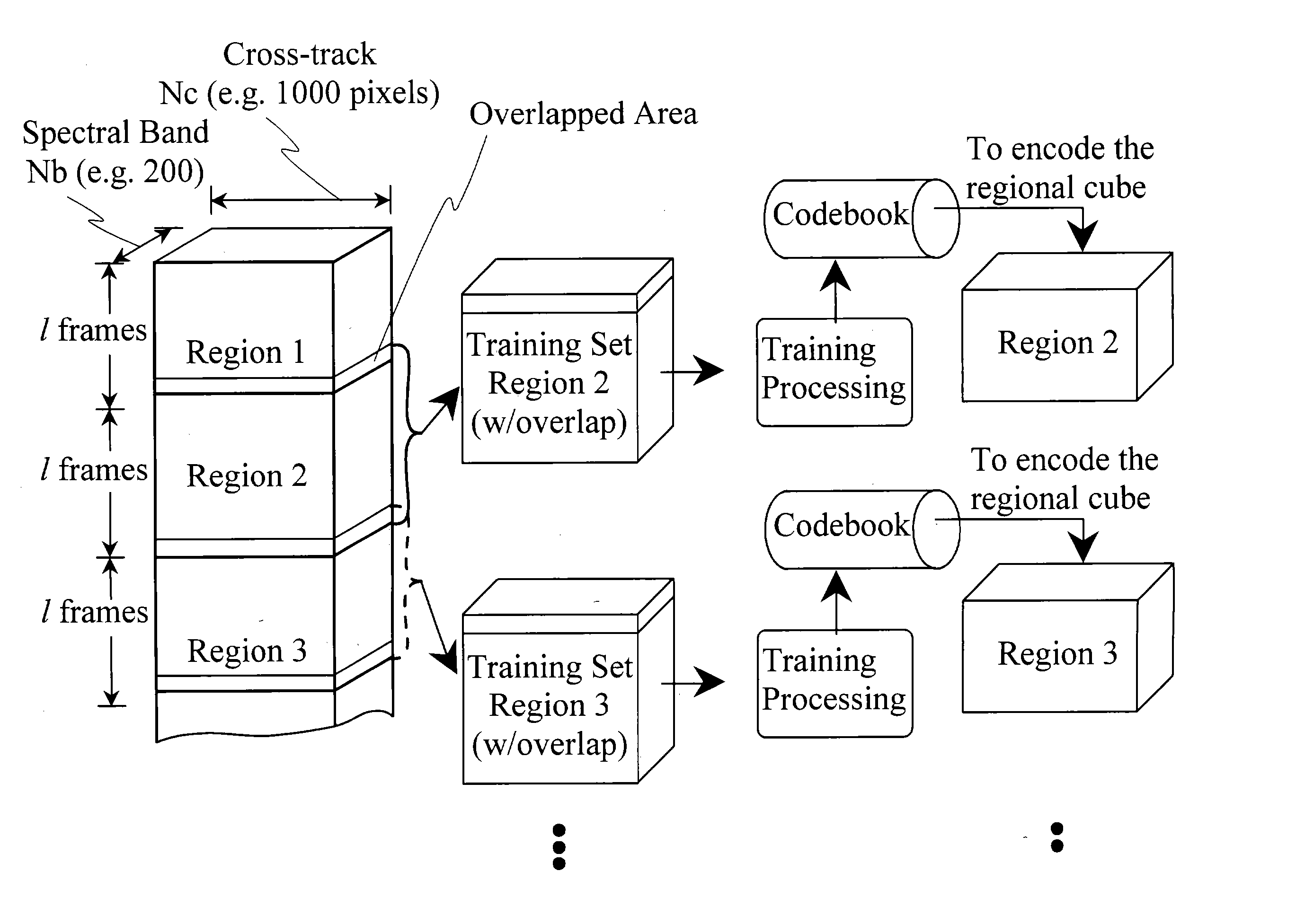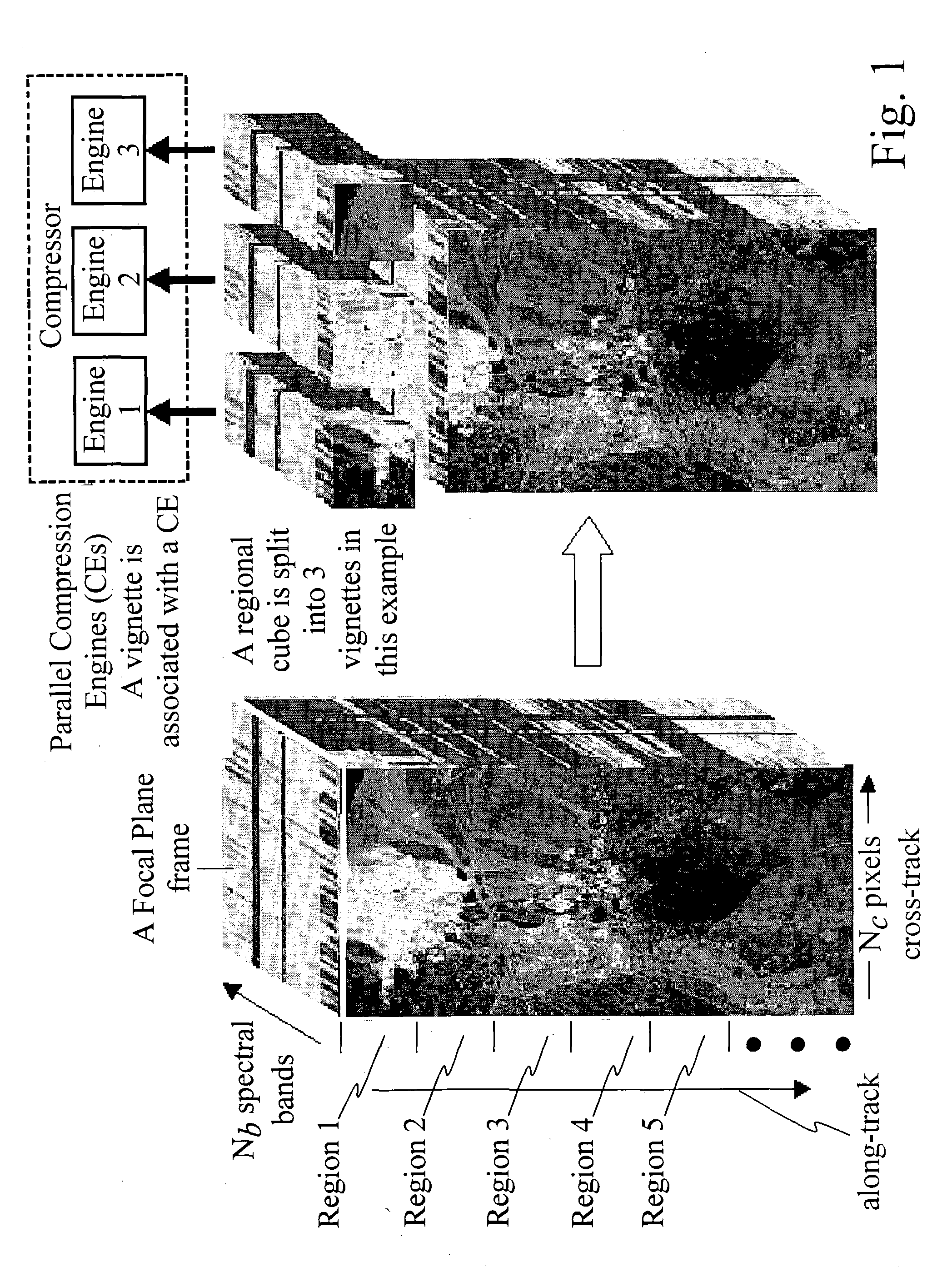Method and system for compressing a continuous data flow in real-time using cluster successive approximation multi-stage vector quantization (SAMVQ)
a continuous data flow and vector quantization technology, applied in image data processing, speech analysis, instruments, etc., can solve the problems of distortion measurement and classification issues arising from lossy compression of hyper-spectral data, and the implementation of lossy compression methods such as vq for real-time data compression of continuous data flow is substantially complicated, and achieves high compression ratio and reduces image artifacts
- Summary
- Abstract
- Description
- Claims
- Application Information
AI Technical Summary
Benefits of technology
Problems solved by technology
Method used
Image
Examples
first embodiment
[0108] In accordance with the invention, instead of dividing a regional data cube into rectangular vignettes a regional data cube is separated into clusters comprising similar spectral vectors. As a result, the similar spectral vectors within a cluster are not located within one specific area of the regional data cube but are associated with particular scenes such as a certain type of vegetation or a water surface. By separating the regional data cube into clusters of similar spectral vectors, no artificial spatial boundaries are introduced, thereby substantially improving image quality. Furthermore, the spectral vectors within a cluster are more easily compressed due to their similarity. Fewer codevectors and fewer approximation stages are used to achieve same or better fidelity compared to the vignette approach resulting in a higher compression ratio.
[0109] For example, a regional data cube is separated into a plurality of clusters in a pre-processing step, applying a classificati...
second embodiment
[0112] In real-time data compression, a series of 2D focal plane frames acquired in a given period of time are treated as a regional data cube for the purpose of dividing a continuous series of 2D focal plane frames into a plurality of data cubes. There will be a visible spatial boundary between two adjacent regions after the data are decompressed, since the compression of each region is independent. This problem is overcome in accordance with a A predetermined number of 2D focal plane frames in a boundary area of a previous regional data cube close to a current regional data cube are included in a training set used for codevector training for the current region, as shown in FIG. 4. Because of the similarity between the spectral vectors of the current regional data cube and those from the overlapped boundary area of the previous regional data cube, the codevectors trained for the current regional data cube—especially the codevectors in a boundary area close to the previous regional...
third embodiment
[0115] A remedy for the single bit error problem is provided in accordance with the invention. Full redundancy of compressed data for a regional data cube is obtained by combining the previous regional data cube and the current regional data cube for codebook training. The codebook trained from the combined regional data cubes enable encoding of both regions. As shown in FIG. 6, a codebook is generated based on regional data cubes 1+2, 2+3, etc. A regional data cube is associated with two codebooks. Regional data cube 1 is associated with codebooks 1 and 2, regional data cube 2 is associated with codebooks 2 and 3, etc. Therefore, each regional data cube has a fully redundant codebook. This redundancy does not reduce the compression ratio since the number of codebooks remains the same. In order to obtain redundancy for the index map, the codebook is used to. encode the current regional data cube as well as the previous regional data cube producing a baseline index map for the curren...
PUM
 Login to View More
Login to View More Abstract
Description
Claims
Application Information
 Login to View More
Login to View More - R&D
- Intellectual Property
- Life Sciences
- Materials
- Tech Scout
- Unparalleled Data Quality
- Higher Quality Content
- 60% Fewer Hallucinations
Browse by: Latest US Patents, China's latest patents, Technical Efficacy Thesaurus, Application Domain, Technology Topic, Popular Technical Reports.
© 2025 PatSnap. All rights reserved.Legal|Privacy policy|Modern Slavery Act Transparency Statement|Sitemap|About US| Contact US: help@patsnap.com



